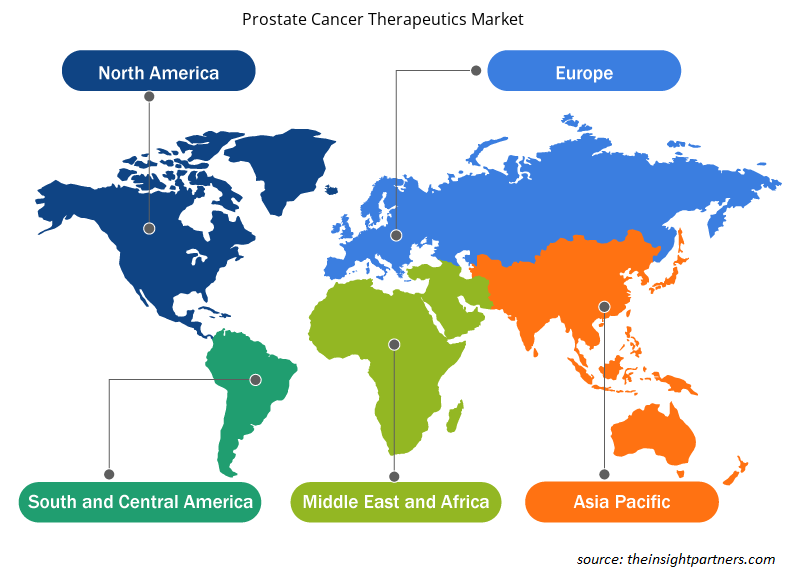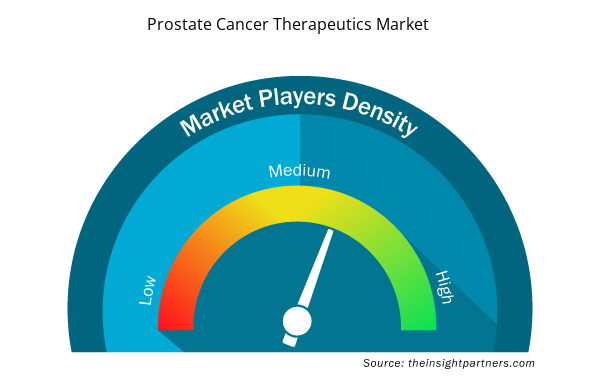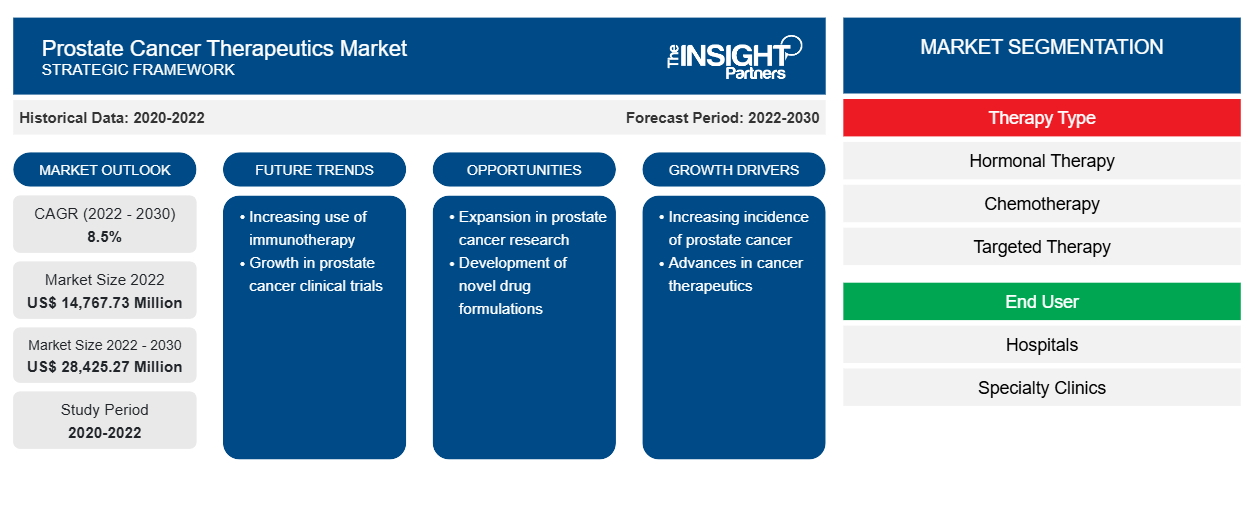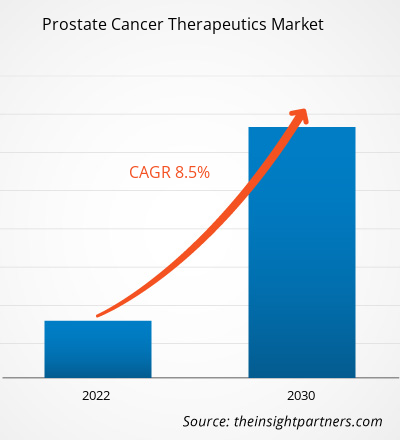[Rapport de recherche] Le marché des thérapies contre le cancer de la prostate devrait passer de 14 767,73 millions USD en 2022 à 28 425,27 millions USD en 2030 ; il devrait enregistrer un TCAC de 8,5 % de 2022 à 2030.
Informations sur le marché et point de vue des analystes :
Le marché des thérapies contre le cancer de la prostate s'agrandit avec l'augmentation des activités de R&D visant à introduire de nouveaux composés médicamenteux, l'augmentation du nombre de cas de cancer de la prostate et l'augmentation du soutien gouvernemental au diagnostic du cancer de la prostate. En outre, la disponibilité de produits avancés par les acteurs du marché stimule la croissance du marché. En janvier 2023, BDR Pharmaceutical a lancé une version générique de l'apalutamide qui est utilisée pour traiter le cancer de la prostate en Inde. Le médicament est lancé sous la marque APATIDE et est prescrit pour traiter le cancer de la prostate non métastatique résistant à la castration et le cancer de la prostate métastatique sensible à la castration.
Moteurs de croissance et défis :
Le cancer de la prostate est l’un des problèmes de santé les plus courants chez les hommes, en particulier chez les hommes âgés de 50 ans et plus. Le cancer de la prostate est surtout fréquent chez les hommes obèses et ayant des antécédents familiaux de cancer de la prostate. Le cancer de la prostate est une menace silencieuse car il se développe souvent sans symptômes notables. Par conséquent, la détection précoce de ce cancer n’est pas si facile. La majorité des cancers de la prostate naissent dans la région périphérique de la prostate. Pour que les symptômes deviennent apparents, le cancer doit atteindre une taille où il exerce une pression sur l’urètre, ou une douleur osseuse due à la métastase peut être le symptôme initial d’un cancer avancé de la prostate dans certains cas. Cependant, toute personne âgée de 50 ans ou plus qui présente des symptômes des voies urinaires inférieures, une dysfonction érectile ou une hématurie doit envisager la possibilité d’un cancer de la prostate. Le cancer de la prostate est la cinquième cause de décès par cancer chez les hommes dans le monde et le deuxième cancer le plus fréquemment diagnostiqué. Même si l'incidence du cancer de la prostate a diminué depuis 2000, on observe une augmentation de l'incidence du cancer de la prostate à un stade avancé à partir de 2010. Les taux d'incidence et de mortalité du cancer de la prostate diffèrent considérablement. Les pays développés ont généralement une incidence plus élevée du cancer de la prostate mais une mortalité plus faible. Le risque de cancer de la prostate aux États-Unis est presque quatre fois plus élevé que le risque mondial. Selon Novartis AG, en 2020, environ 1,4 million de nouveaux cas de cancer de la prostate et environ 375 000 décès par cancer de la prostate ont été signalés dans le monde. Le nombre croissant de cas de cancer de la prostate dans le monde et le faible taux de détection du cancer de la prostate alimentent la croissance du marché des thérapies contre le cancer de la prostate.
Personnalisez ce rapport en fonction de vos besoins
Vous bénéficierez d'une personnalisation gratuite de n'importe quel rapport, y compris de certaines parties de ce rapport, d'une analyse au niveau des pays, d'un pack de données Excel, ainsi que de superbes offres et réductions pour les start-ups et les universités.
- Obtenez les principales tendances clés du marché de ce rapport.Cet échantillon GRATUIT comprendra une analyse de données, allant des tendances du marché aux estimations et prévisions.
Segmentation et portée du rapport :
Le marché des thérapies contre le cancer de la prostate est segmenté en fonction du type de thérapie, de l'utilisateur final et de la géographie. Le marché des thérapies contre le cancer de la prostate, par type de thérapie, est segmenté en hormonothérapie, chimiothérapie, immunothérapie, thérapie ciblée et autres. Le marché des thérapies contre le cancer de la prostate, par utilisateur final, est segmenté en hôpitaux, cliniques spécialisées et autres. En fonction de la géographie, le marché des thérapies contre le cancer de la prostate est segmenté en Amérique du Nord (États-Unis, Canada et Mexique), Europe (Royaume-Uni, Allemagne, France, Italie, Espagne et reste de l'Europe), Asie-Pacifique (Chine, Japon, Inde, Corée du Sud, Australie et reste de l'Asie-Pacifique), Moyen-Orient et Afrique (Émirats arabes unis, Arabie saoudite, Afrique du Sud et reste du Moyen-Orient et de l'Afrique) et Amérique du Sud et centrale (Brésil, Argentine et reste de l'Amérique du Sud et centrale).
Analyse segmentaire :
Le marché des thérapies contre le cancer de la prostate, par type de thérapie, est segmenté en hormonothérapie, chimiothérapie, immunothérapie, thérapie ciblée et autres. En 2022, le segment de l'hormonothérapie détenait la plus grande part de marché après la chimiothérapie, et le même segment devrait enregistrer le TCAC le plus élevé de 2022 à 2030. La chimiothérapie est considérée comme un traitement important pour le cancer de la prostate. Dans cette thérapie, les médicaments détruisent les cellules cancéreuses nouvelles ou existantes dans les poumons. La chimiothérapie pour le cancer métastatique de la prostate peut soulager les symptômes. Elle peut également aider à réduire le cancer et à améliorer la qualité de vie. Le docétaxel (Taxotere) est considéré comme la norme de soins dans la chimiothérapie du cancer de la prostate chez les patients résistants à l'hormonothérapie. La FDA a également approuvé le médicament de chimiothérapie cabazitaxel (Jevtana) pour le traitement du cancer de la prostate résistant à la castration. Il est également utilisé pour les patients atteints d'un cancer de la prostate métastatique qui s'est développé pendant la prise de docétaxel.
Analyse régionale :
Le marché des traitements contre le cancer de la prostate est segmenté géographiquement en Amérique du Nord, Europe, Asie-Pacifique, Moyen-Orient et Afrique, et Amérique du Sud et centrale. L'Amérique du Nord est le principal contributeur à la croissance du marché mondial des traitements contre le cancer de la prostate. L'Asie-Pacifique devrait enregistrer le TCAC le plus élevé sur le marché des traitements contre le cancer de la prostate de 2022 à 2030. La croissance du marché des traitements contre le cancer de la prostate aux États-Unis est principalement tirée par l'incidence croissante des cas de cancer de la prostate, les lancements de produits et les initiatives gouvernementales. En juin 2023, Lynparza (olaparib) d'AstraZeneca et MSD en association avec la prednisone ou la prednisolone et l'abiratérone a été approuvé aux États-Unis pour traiter les patients adultes atteints d'un cancer de la prostate métastatique résistant à la castration (mCRPC) suspecté d'être muté par le gène BRCA délétère (BRCAm). De plus, en novembre 2023, la FDA a approuvé l'enzalutamide, un produit fabriqué par Astellas Pharma US, Inc. Le produit est utilisé pour le traitement du cancer de la prostate sensible à la castration non métastatique (nmCSPC) avec récidive biochimique à haut risque de métastase (BCR à haut risque).
Aperçu régional du marché des thérapies contre le cancer de la prostate
Les tendances et facteurs régionaux influençant le marché des thérapies contre le cancer de la prostate tout au long de la période de prévision ont été expliqués en détail par les analystes d’Insight Partners. Cette section traite également des segments et de la géographie du marché des thérapies contre le cancer de la prostate en Amérique du Nord, en Europe, en Asie-Pacifique, au Moyen-Orient et en Afrique, ainsi qu’en Amérique du Sud et en Amérique centrale.

- Obtenez les données régionales spécifiques au marché des thérapies contre le cancer de la prostate
Portée du rapport sur le marché des thérapies contre le cancer de la prostate
| Attribut de rapport | Détails |
|---|---|
| Taille du marché en 2022 | 14 767,73 millions de dollars américains |
| Taille du marché d'ici 2030 | 28 425,27 millions de dollars américains |
| Taux de croissance annuel moyen mondial (2022-2030) | 8,5% |
| Données historiques | 2020-2022 |
| Période de prévision | 2022-2030 |
| Segments couverts | Par type de thérapie
|
| Régions et pays couverts | Amérique du Nord
|
| Leaders du marché et profils d'entreprises clés |
|
Densité des acteurs du marché : comprendre son impact sur la dynamique des entreprises
Le marché des thérapies contre le cancer de la prostate connaît une croissance rapide, tirée par la demande croissante des utilisateurs finaux en raison de facteurs tels que l'évolution des préférences des consommateurs, les avancées technologiques et une plus grande sensibilisation aux avantages du produit. À mesure que la demande augmente, les entreprises élargissent leurs offres, innovent pour répondre aux besoins des consommateurs et capitalisent sur les tendances émergentes, ce qui alimente davantage la croissance du marché.
La densité des acteurs du marché fait référence à la répartition des entreprises ou des sociétés opérant sur un marché ou un secteur particulier. Elle indique le nombre de concurrents (acteurs du marché) présents sur un marché donné par rapport à sa taille ou à sa valeur marchande totale.
Les principales entreprises opérant sur le marché des thérapies contre le cancer de la prostate sont :
- Astella Pharma Inc
- Services Johnson & Johnson Inc.
- Eli Lilly et compagnie
- Bayer AG
- Sanofi
Avis de non-responsabilité : les sociétés répertoriées ci-dessus ne sont pas classées dans un ordre particulier.

- Obtenez un aperçu des principaux acteurs du marché des thérapies contre le cancer de la prostate
Développements de l'industrie et opportunités futures :
Diverses initiatives d’acteurs clés opérant sur le marché des thérapies contre le cancer de la prostate sont énumérées ci-dessous :
- En mars 2022, la FDA américaine a approuvé le Pluvicto (lutécium Lu 177 vipivotide tétraxétan) de Novartis pour le traitement des patients adultes atteints d'un type de cancer de la prostate avancé appelé cancer de la prostate métastatique résistant à la castration positif à l'antigène membranaire spécifique de la prostate (PSMA-positif mCRPC).
- En avril 2023, la FDA a accordé à Lantheus Holdings Inc et POINT Biopharma Global Inc la désignation accélérée pour le 177Lu-PNT2002 pour le traitement du cancer de la prostate métastatique résistant à la castration (mCRPC). Le PNT2002 est une thérapie radiopharmaceutique innovante à base de 177Lu ciblant le PSMA qui combine un ligand ciblant le PSMA, le PSMA-I&T et le 177Lu radio-isotope émetteur bêta sans porteur ajouté pour le traitement du mCRPC.
Paysage concurrentiel et entreprises clés :
Astella Pharma Inc, Johnson & Johnson Services Inc, Eli Lilly and Company, Bayer AG, Sanofi, Merck KGaA, AstraZeneca, Novartis AG, AbbVie et Bristol Myers Squibb comptent parmi les principaux acteurs du marché des traitements contre le cancer de la prostate. Ces acteurs du marché se concentrent sur le lancement de nouveaux produits et l'expansion géographique pour répondre à la demande croissante des consommateurs du monde entier et élargir leur gamme de produits dans des portefeuilles spécialisés. Leur présence mondiale leur permet de servir une large base de clients, facilitant ainsi l'expansion du marché.
- Analyse historique (2 ans), année de base, prévision (7 ans) avec TCAC
- Analyse PEST et SWO
- Taille du marché Valeur / Volume - Mondial, Régional, Pays
- Industrie et paysage concurrentiel
- Ensemble de données Excel



Report Coverage
Revenue forecast, Company Analysis, Industry landscape, Growth factors, and Trends

Segment Covered
This text is related
to segments covered.

Regional Scope
North America, Europe, Asia Pacific, Middle East & Africa, South & Central America

Country Scope
This text is related
to country scope.
Questions fréquemment posées
Based on geography, the prostate cancer therapeutics market is segmented into North America (the US, Canada, and Mexico), Europe (the UK, Germany, France, Italy, Spain, and the Rest of Europe), Asia Pacific (China, Japan, India, South Korea, Australia, and the Rest of Asia Pacific), the Middle East & Africa (the UAE, Saudi Arabia, South Africa, and Rest of the Middle East & Africa), and South & Central America (Brazil, Argentina, and the Rest of South & Central America). North America is the largest contributor to global prostate cancer therapeutics market growth. Asia Pacific is expected to register the highest CAGR in the prostate cancer therapeutics market from 2022 to 2030.
The prostate cancer therapeutics market, by therapy type, is segmented into hormone therapy, chemotherapy, immunotherapy, targeted therapy, and others. In 2022, the chemotherapy segment held the largest market share, and the same segment is expected to record the highest CAGR from 2022 to 2030.
The prostate cancer therapeutics market, by end-user, is segmented into hospitals, specialty clinics, and others. In 2022, the hospital segment held the largest market share; moreover, the same segment is expected to record the highest CAGR during 2022–2030.
The increasing cases of prostate cancer and strategic initiatives in prostate cancer therapeutics freezer bolster the prostate cancer therapeutics market size. However, the high cost associated with prostate cancer therapeutics hinders the growth of prostate cancer therapeutics market growth.
The prostate cancer therapeutics market majorly consists of players such Astella Pharma Inc, Johnson & Johnson Services Inc, Eli Lilly and Company, Bayer AG, Sanofi, Merck KGaA, AstraZeneca, Novartis AG, AbbVie, and Bristol Myers Squibb
Prostate cancer is one of the most common health problems in men, especially in older men (aged above 50 years). Prostate cancer is mostly common in men who are obese and have a family history of prostate cancer. Prostate cancer is a silent threat that often develops without noticeable symptoms, and hence, early detection of this cancer is not that easy. Typically, the majority of prostate cancers originate in the peripheral region of the prostate gland. Consequently, for symptoms to become apparent, the cancer must reach a size where it exerts pressure on the urethra, or in some cases, bone pain from the metastasis might be the initial presenting symptom of advanced prostate cancer. However, any individual aged 50 or above who presents with lower urinary tract symptoms, erectile dysfunction, or hematuria should consider the possibility of prostate cancer.
Trends and growth analysis reports related to Life Sciences : READ MORE..
The List of Companies - Prostate Cancer Market
- Astella Pharma Inc
- Johnson & Johnson Services Inc
- Eli Lilly, and Company
- Bayer AG
- Sanofi
- Merck KGaA
- AstraZeneca
- Novartis AG
- AbbVie
- Bristol Myers Squibb
The Insight Partners performs research in 4 major stages: Data Collection & Secondary Research, Primary Research, Data Analysis and Data Triangulation & Final Review.
- Data Collection and Secondary Research:
As a market research and consulting firm operating from a decade, we have published and advised several client across the globe. First step for any study will start with an assessment of currently available data and insights from existing reports. Further, historical and current market information is collected from Investor Presentations, Annual Reports, SEC Filings, etc., and other information related to company’s performance and market positioning are gathered from Paid Databases (Factiva, Hoovers, and Reuters) and various other publications available in public domain.
Several associations trade associates, technical forums, institutes, societies and organization are accessed to gain technical as well as market related insights through their publications such as research papers, blogs and press releases related to the studies are referred to get cues about the market. Further, white papers, journals, magazines, and other news articles published in last 3 years are scrutinized and analyzed to understand the current market trends.
- Primary Research:
The primarily interview analysis comprise of data obtained from industry participants interview and answers to survey questions gathered by in-house primary team.
For primary research, interviews are conducted with industry experts/CEOs/Marketing Managers/VPs/Subject Matter Experts from both demand and supply side to get a 360-degree view of the market. The primary team conducts several interviews based on the complexity of the markets to understand the various market trends and dynamics which makes research more credible and precise.
A typical research interview fulfils the following functions:
- Provides first-hand information on the market size, market trends, growth trends, competitive landscape, and outlook
- Validates and strengthens in-house secondary research findings
- Develops the analysis team’s expertise and market understanding
Primary research involves email interactions and telephone interviews for each market, category, segment, and sub-segment across geographies. The participants who typically take part in such a process include, but are not limited to:
- Industry participants: VPs, business development managers, market intelligence managers and national sales managers
- Outside experts: Valuation experts, research analysts and key opinion leaders specializing in the electronics and semiconductor industry.
Below is the breakup of our primary respondents by company, designation, and region:

Once we receive the confirmation from primary research sources or primary respondents, we finalize the base year market estimation and forecast the data as per the macroeconomic and microeconomic factors assessed during data collection.
- Data Analysis:
Once data is validated through both secondary as well as primary respondents, we finalize the market estimations by hypothesis formulation and factor analysis at regional and country level.
- Macro-Economic Factor Analysis:
We analyse macroeconomic indicators such the gross domestic product (GDP), increase in the demand for goods and services across industries, technological advancement, regional economic growth, governmental policies, the influence of COVID-19, PEST analysis, and other aspects. This analysis aids in setting benchmarks for various nations/regions and approximating market splits. Additionally, the general trend of the aforementioned components aid in determining the market's development possibilities.
- Country Level Data:
Various factors that are especially aligned to the country are taken into account to determine the market size for a certain area and country, including the presence of vendors, such as headquarters and offices, the country's GDP, demand patterns, and industry growth. To comprehend the market dynamics for the nation, a number of growth variables, inhibitors, application areas, and current market trends are researched. The aforementioned elements aid in determining the country's overall market's growth potential.
- Company Profile:
The “Table of Contents” is formulated by listing and analyzing more than 25 - 30 companies operating in the market ecosystem across geographies. However, we profile only 10 companies as a standard practice in our syndicate reports. These 10 companies comprise leading, emerging, and regional players. Nonetheless, our analysis is not restricted to the 10 listed companies, we also analyze other companies present in the market to develop a holistic view and understand the prevailing trends. The “Company Profiles” section in the report covers key facts, business description, products & services, financial information, SWOT analysis, and key developments. The financial information presented is extracted from the annual reports and official documents of the publicly listed companies. Upon collecting the information for the sections of respective companies, we verify them via various primary sources and then compile the data in respective company profiles. The company level information helps us in deriving the base number as well as in forecasting the market size.
- Developing Base Number:
Aggregation of sales statistics (2020-2022) and macro-economic factor, and other secondary and primary research insights are utilized to arrive at base number and related market shares for 2022. The data gaps are identified in this step and relevant market data is analyzed, collected from paid primary interviews or databases. On finalizing the base year market size, forecasts are developed on the basis of macro-economic, industry and market growth factors and company level analysis.
- Data Triangulation and Final Review:
The market findings and base year market size calculations are validated from supply as well as demand side. Demand side validations are based on macro-economic factor analysis and benchmarks for respective regions and countries. In case of supply side validations, revenues of major companies are estimated (in case not available) based on industry benchmark, approximate number of employees, product portfolio, and primary interviews revenues are gathered. Further revenue from target product/service segment is assessed to avoid overshooting of market statistics. In case of heavy deviations between supply and demand side values, all thes steps are repeated to achieve synchronization.
We follow an iterative model, wherein we share our research findings with Subject Matter Experts (SME’s) and Key Opinion Leaders (KOLs) until consensus view of the market is not formulated – this model negates any drastic deviation in the opinions of experts. Only validated and universally acceptable research findings are quoted in our reports.
We have important check points that we use to validate our research findings – which we call – data triangulation, where we validate the information, we generate from secondary sources with primary interviews and then we re-validate with our internal data bases and Subject matter experts. This comprehensive model enables us to deliver high quality, reliable data in shortest possible time.


 Obtenez un échantillon gratuit pour ce rapport
Obtenez un échantillon gratuit pour ce rapport